A Study on the Effect of Performance Factor on GSHP System through Real-Scale Experiments in Korea
Abstract
1. Introduction
2. Materials and Methods
2.1. Purpose of Experiments
2.2. Experimental Setup
2.3. Experimental Method
2.3.1. Performance Comparison According to the GHEX Shape
2.3.2. Performance Comparison According to the Introduction of HST
2.3.3. Performance Comparison According to the GHEX Length
2.4. Measurement Method and Performance Calculation
2.4.1. Performance Calculation Equation
2.4.2. Uncertainty Analysis
3. Result and Discussion
3.1. Performance Analysis According to the GHEX Shape
3.2. Performance Analysis According to the Introduction of HST
3.3. Performance Comparison According to the GHEX Length
3.4. Effectiveness Analysis by Design Factor
3.5. Compare to Previous Research
4. Conclusions
- From the performance analysis, according to the ground heat exchanger, the heat transfer rate, heat pump COP, and system COP of the conventional ground heat exchanger were 7.41 kW, 2.98, and 1.94, respectively. Those of the inner rib ground heat exchanger was 7.95 kW, 3.04, and 1.97, respectively.
- As the result of performance analysis according to the capacity of heat storage tank, the heat transfer rate, heat pump COP, and system COP of 50 m3 heat storage tank were 66.1 kW, 3.11, and 2.29, respectively. Those of the 20 m3 heat storage tank were 68.6 kW, 2.33, and 3.18, respectively. When the heat storage tank was not used, the heat exchanger rate was 58.4 kW, heat pump COP was 2.96, and the system COP was 2.32.
- The longer the length of the ground heat exchanger, the higher the heat transfer rate. If the length of the ground heat exchanger is between 1050 and 1500 m, the heat transfer rate decreases by 0.153 kW per unit of the ratio of heat pump rated capacity to ground heat exchanger length. However, the heat transfer rate per unit length increases. The heat pump COP decrease by 0.0043 per unit of the ratio of heat pump rated capacity to ground heat exchanger length. The system COP decrease by 0.0029 per unit ratio.
- When the ground heat exchanger type, length, and storage tank capacity were adjusted within the designable range, the most important factor affecting heat transfer rate and heat pump COP was heat storage capacity. According to the heat storage capacity, heat exchanger rate increased 17% and heat pump COP increased 7%. The most important factor affecting the system COP was the ground heat exchanger length. As the length of the ground heat exchanger increased from 1050 to 1500 m, the system COP increased by 4%.
Author Contributions
Funding
Acknowledgments
Conflicts of Interest
Nomenclature
| specific heat capacity (kJ/kg·K) | |
| COP | coefficient of performance (-) |
| absolute uncertainty () | |
| fractional uncertainty (-) | |
| length (m) | |
| mass flow rate (kg/s) | |
| power (W) | |
| heat transfer rate (W) | |
| R | overall resistance of ground and borehole (m·K/W) |
| temperature (K) | |
| Subscript | |
| variation | |
| borehole | |
| flow rate | |
| ground heat exchanger side | |
| heat pump side | |
| heat pump | |
| unit length | |
| power | |
| pump | circulation pump |
| heat transfer rate | |
| ground | |
| heat storage tank side | |
| system | |
| Abbreviations | |
| ASHRAE | American society of heaing, refrigerating and air-conditioning engineers |
| EWT | entering water temperature |
| FCU | fan coil unit |
| GHEX | ground heat exchanger |
| GSHP | ground source heat pump |
| HDPE | high-density polyethylene |
| HP | heat pump |
| HST | heat storage tank |
| TRT | thermal response test |
| RIB | inner rib |
| VGHSP | vertical ground source heat pump |
| ZEB | zero energy building |
References
- Korea Energy Agency. Zero Energy Building. Available online: https://zeb.energy.or.kr (accessed on 3 November 2019).
- Hahn, J.-S.; Han, H.-S.; Hahn, C. Geothermal Energy; Hanrimwon: Seoul, Korea, 2010. [Google Scholar]
- Design Guide for Ground Source Heat Pump System. Available online: www.kiaebs.org (accessed on 26 Janunary 2017).
- Kavanaugh, S.; Rafferty, K. Geothermal heating and cooling: Design of ground-source heat pump systems. In Proceedings of the ASHRAE Transactions, New York, NY, USA, 18–22 January 2014; Volume 120. [Google Scholar]
- Pu, L.; Qi, D.; Li, K.; Tan, H.; Li, Y. Simulation study on the thermal performance of vertical U-tube heat exchangers for ground source heat pump system. Appl. Therm. Eng. 2015, 79, 202–213. [Google Scholar] [CrossRef]
- Li, C.; Mao, J.; Zhang, H.; Xing, Z.; Li, Y.; Zhou, J. Numerical simulation of horizontal spiral-coil ground source heat pump system: Sensitivity analysis and operation characteristics. Appl. Therm. Eng. 2017, 110, 424–435. [Google Scholar] [CrossRef]
- Luo, J.; Luo, Z.; Xie, J.; Xia, D.; Huang, W.; Shao, H.; Xiang, W.; Rohn, J. Investigation of shallow geothermal potentials for different types of ground source heat pump systems (GSHP) of Wuhan city in China. Renew. Energy 2018, 118, 230–244. [Google Scholar] [CrossRef]
- Quaggiotto, D.; Zarrella, A.; Emmi, G.; De Carli, M.; Pockelé, L.; Vercruysse, J.; Psyk, M.; Righini, D.; Galgaro, A.; Mendrinos, D.; et al. Simulation-based comparison between the thermal behavior of coaxial and double U-tube borehole heat exchangers. Energies 2019, 12, 2321. [Google Scholar] [CrossRef]
- Bae, S.M.; Nam, Y.; Choi, J.M.; Lee, K.H.; Choi, J.S. Analysis on thermal performance of ground heat exchanger according to design type based on thermal response test. Energies 2019, 12, 651. [Google Scholar] [CrossRef]
- Qi, D.; Pu, L.; Ma, Z.; Xia, L.; Li, Y. Effects of ground heat exchangers with different connection configurations on the heating performance of GSHP systems. Geothermics 2019, 80, 20–30. [Google Scholar] [CrossRef]
- Kim, M.J.; Seo, B.M.; Lee, J.M.; Choi, J.M.; Lee, K.H. Operational behavior characteristics and energy saving potential of vertical closed loop ground source heat pump system combined with storage tank in an office building. Energy Build. 2018, 179, 239–252. [Google Scholar] [CrossRef]
- Yu, M.G.; Nam, Y.; Lee, K.H. Design method of heat storage type ground source heat pump system considering energy load pattern of greenhouse. Korea Inst. Ecol. Archit. Environ. 2015, 15, 57–63. [Google Scholar]
- Spitler, J.D.; Gehlin, S. Measured performance of a mixed-use commercial-building ground source heat pump system in Sweden. Energies 2019, 12, 2020. [Google Scholar] [CrossRef]
- Bae, S.M.; Nam, Y.; Shim, B.O. Feasibility study of ground source heat pump system considering underground thermal properties. Energies 2018, 11, 1786. [Google Scholar] [CrossRef]
- Chen, S.; Mao, J.; Han, X. Heat transfer analysis a vertical ground heat exchanger using numerical simulation and multiple regression model. Energy Build. 2016, 129, 81–91. [Google Scholar] [CrossRef]
- Hughes, D. Monitoring of Non-Domestic Renewable Heat Incentive Ground-Source & Water-Source Heat Pumps; Final Report; UK Department for Business, Energy & Industrial Strategy; Department of Energy & Climate Change: London, UK, 2018. [Google Scholar]
- Lu, Y.; Hooman, K.; Atrens, A.D.; Russell, H. An experimental facility to validate ground source heat pump optimisation models for the australian climate. Energies 2017, 10, 138. [Google Scholar] [CrossRef]
- Xi, J.; Li, Y.; Liu, M.; Wang, R.Z. Study on the thermal effect of the ground heat exchanger of GSHP in the eastern China area. Energy 2017, 141, 56–65. [Google Scholar] [CrossRef]
- Habibi, M.; Hakkaki-Fard, A. Long-term energy and exergy analysis of heat pumps with different types of ground and air heat exchangers. Int. J. Refrig. 2019, 100, 414–433. [Google Scholar] [CrossRef]
- Taylor, J.R. An Introduction to Error Analysis—The Study of Uncertainties in Physical Measurements, 2nd ed.; University Science Books: Sausalito, CA, USA, 1997. [Google Scholar]
- Ingersoll, L.R.; Zobel, O.J.; Ingersoll, A.C. Heat Conduction: With Engineering and Geological Applications, 2nd ed.; McGraw Hill: NewYork, NY, USA, 1954. [Google Scholar]
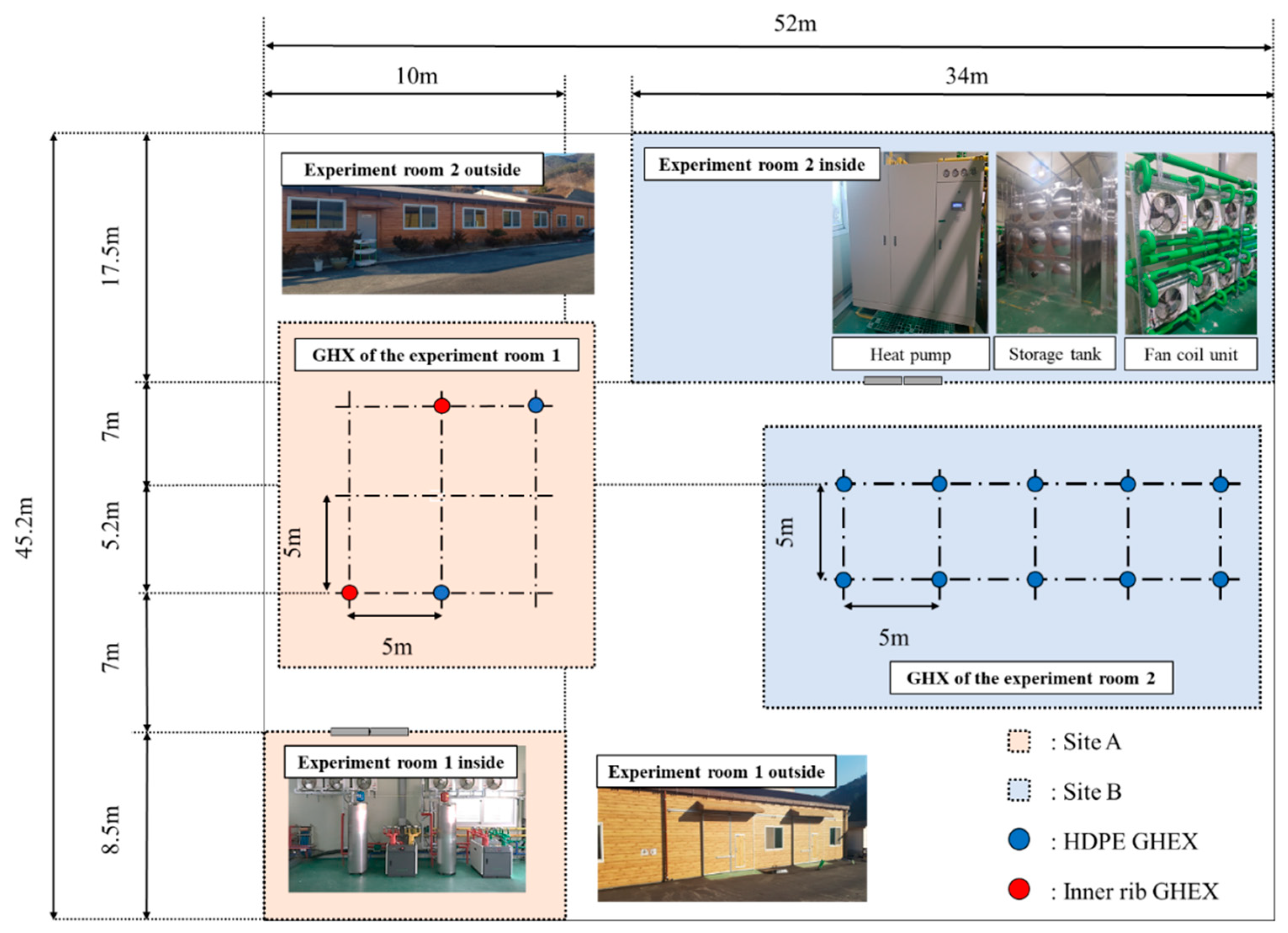
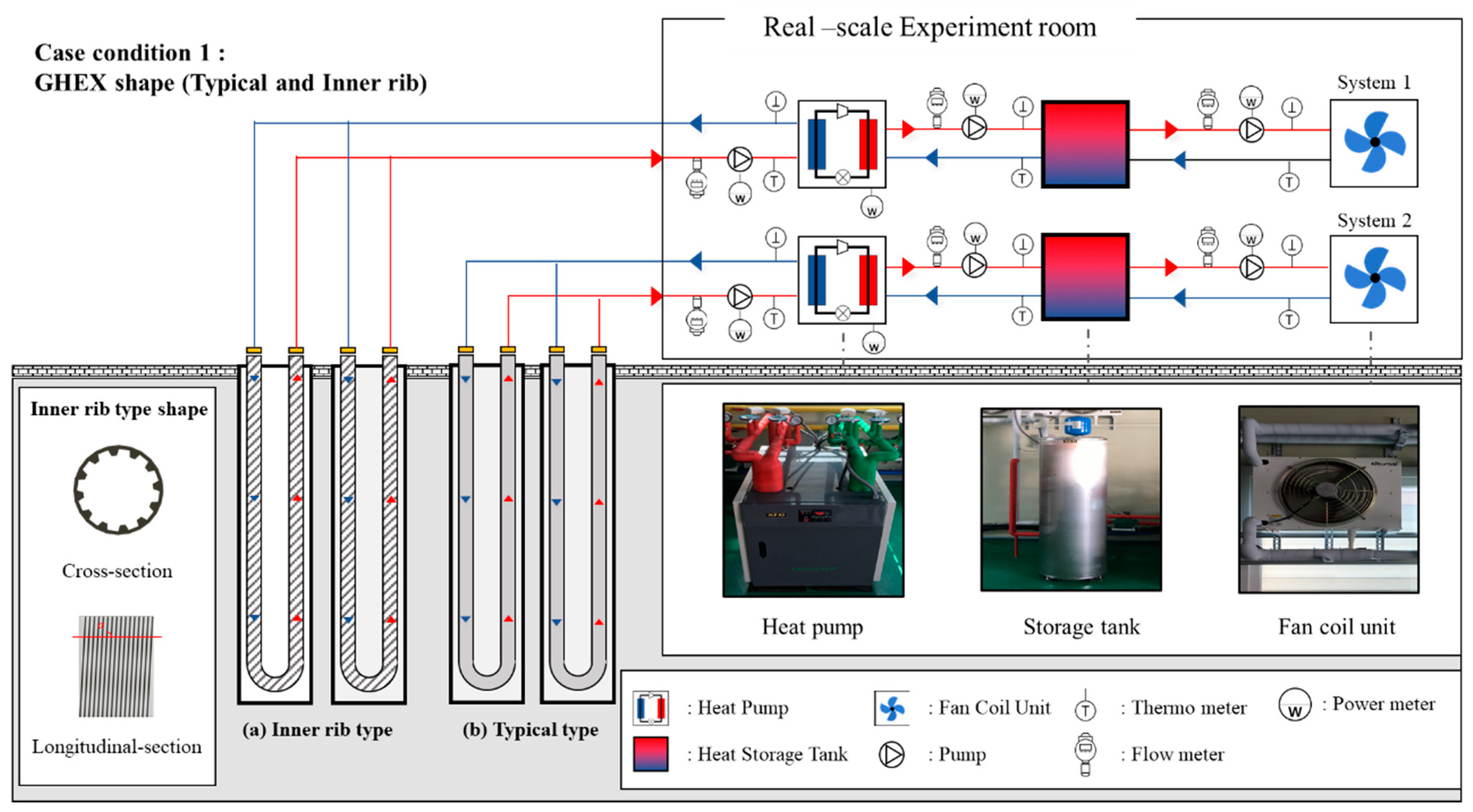
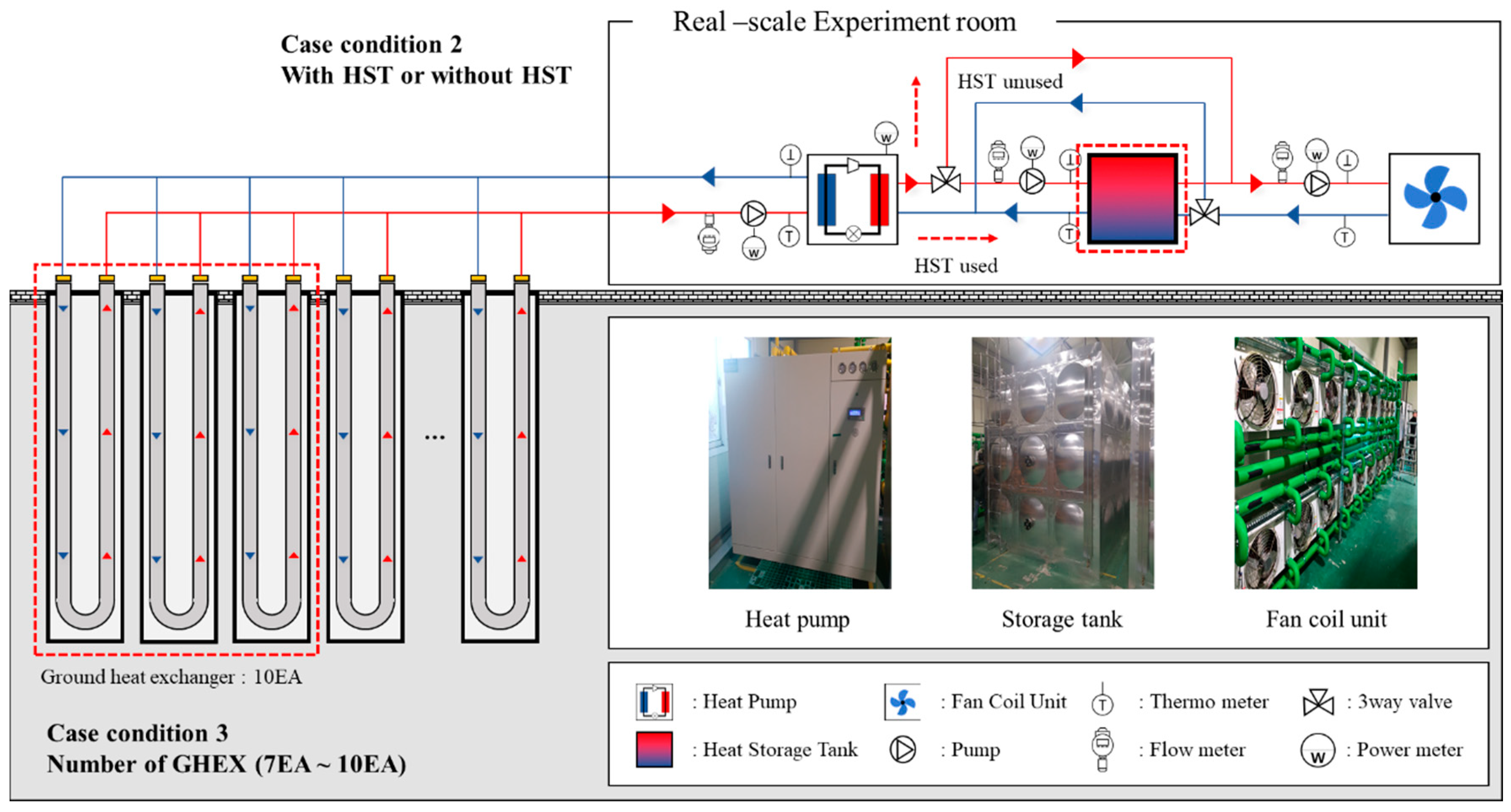
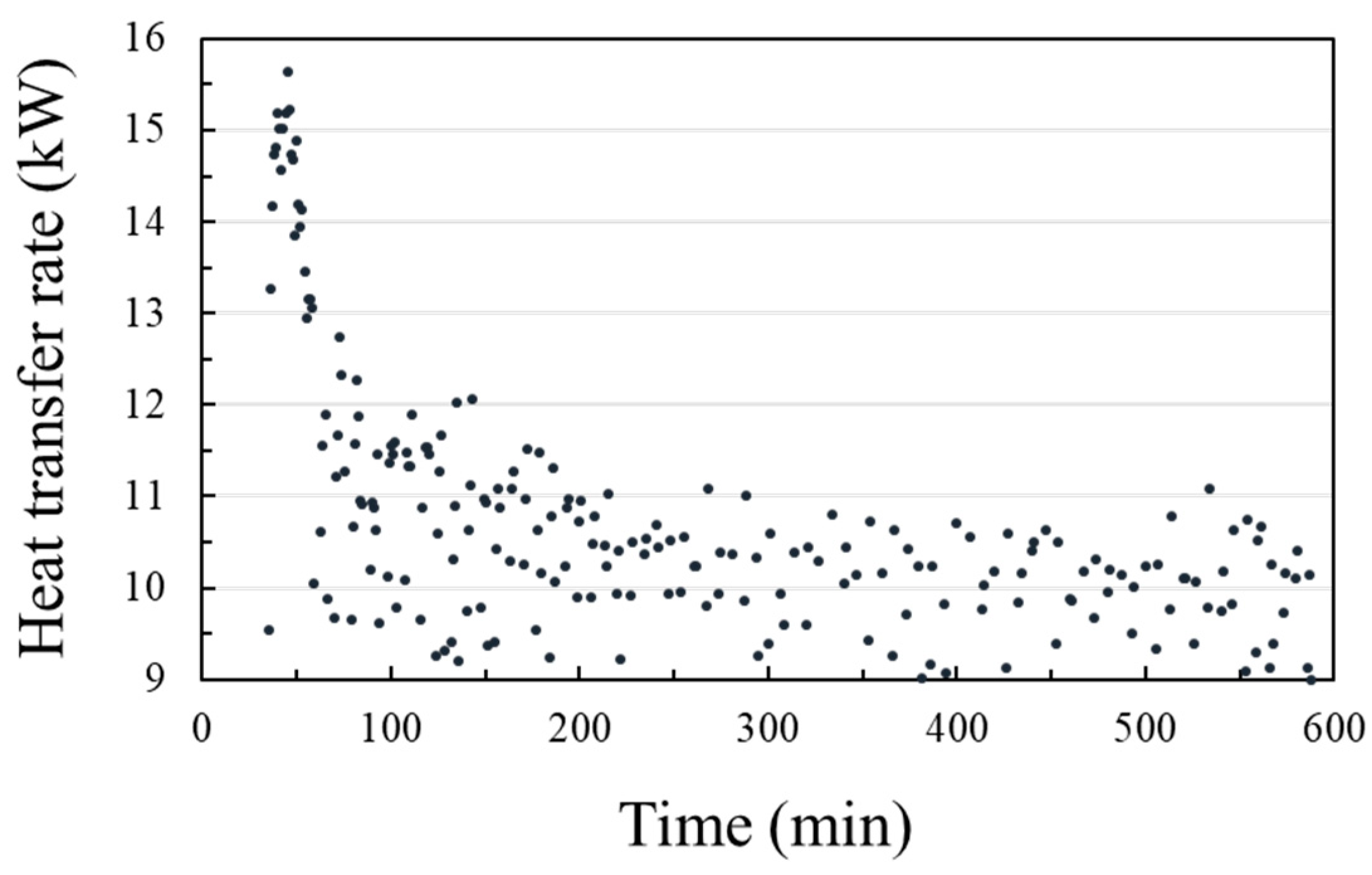
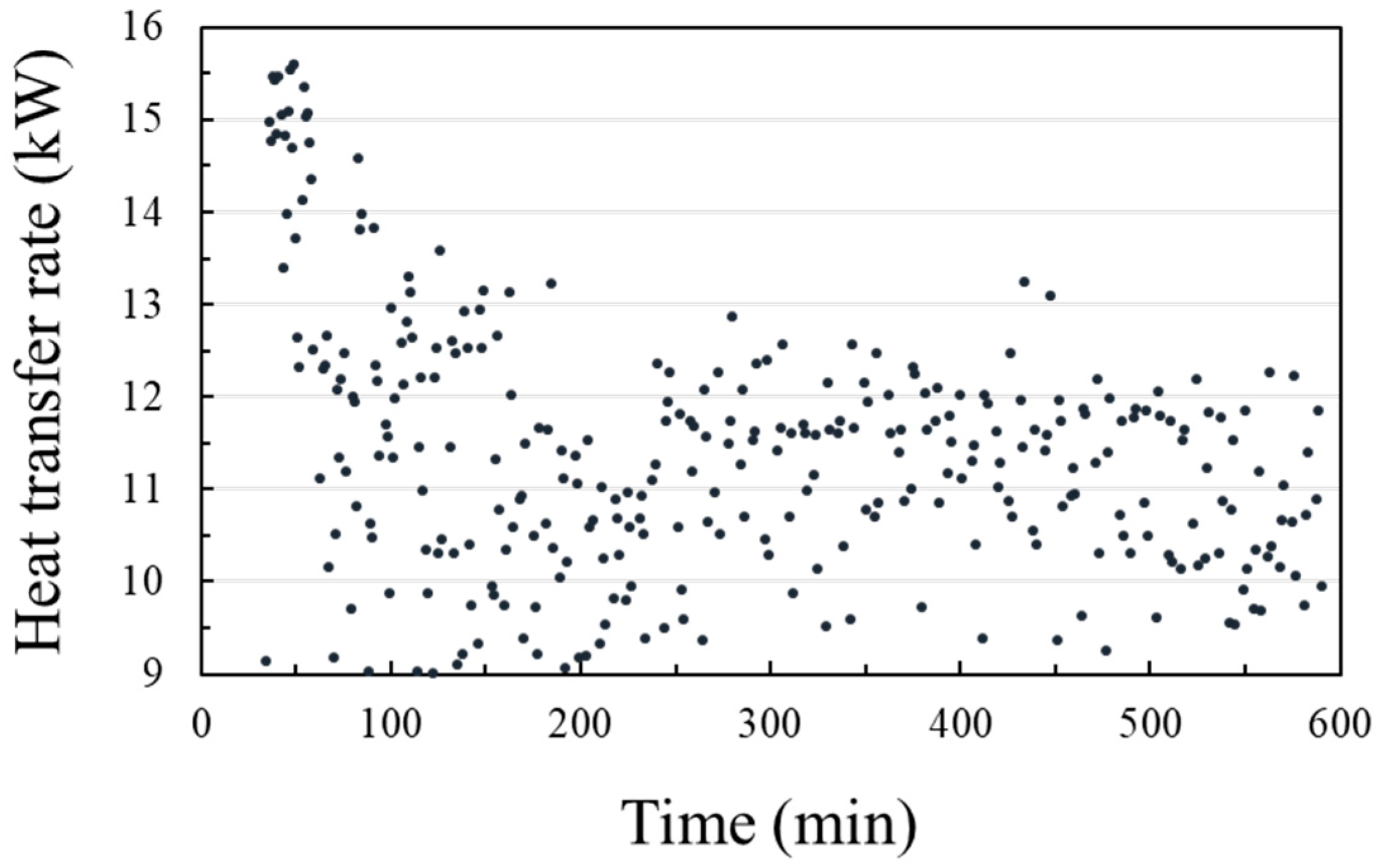
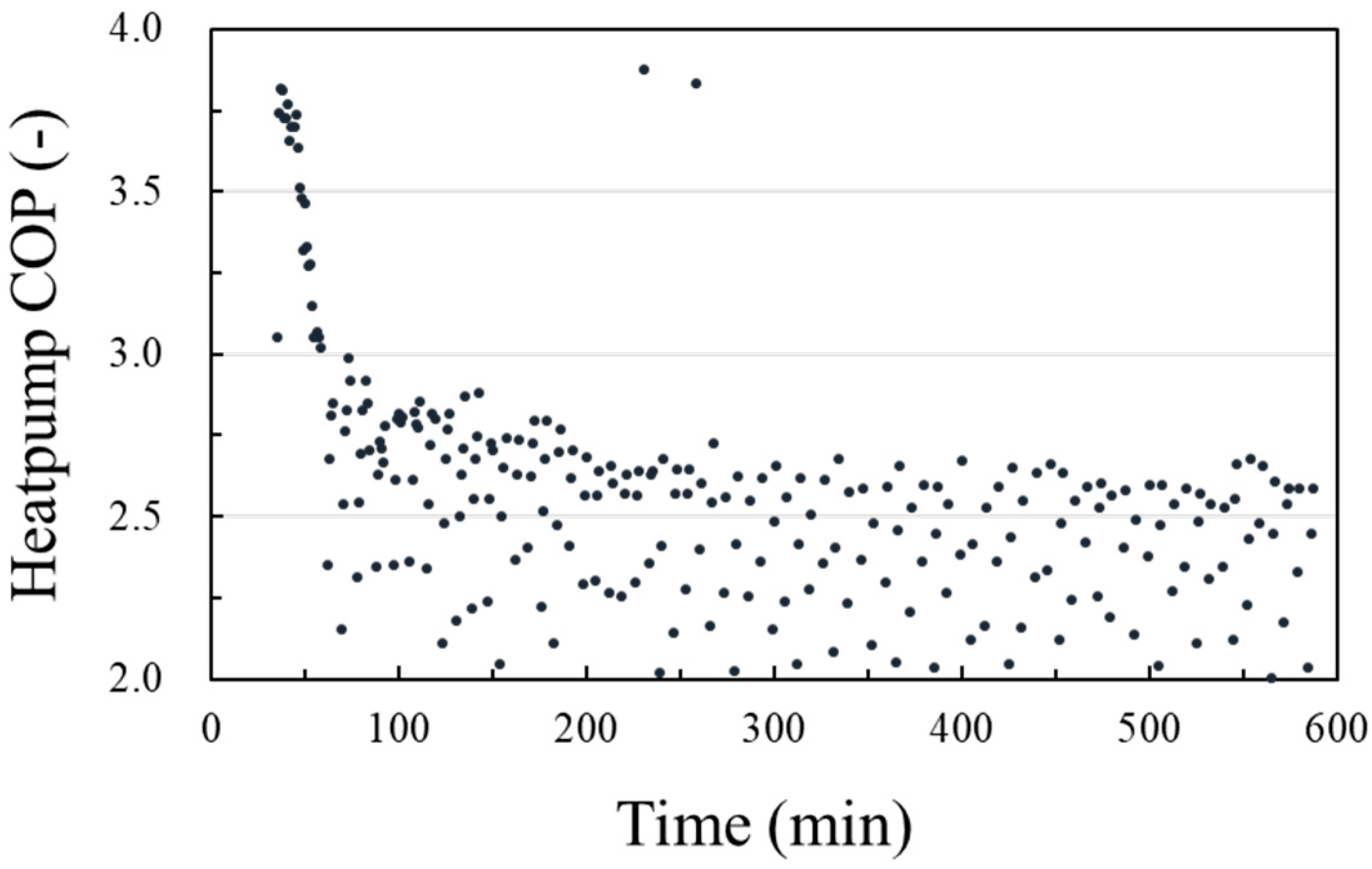
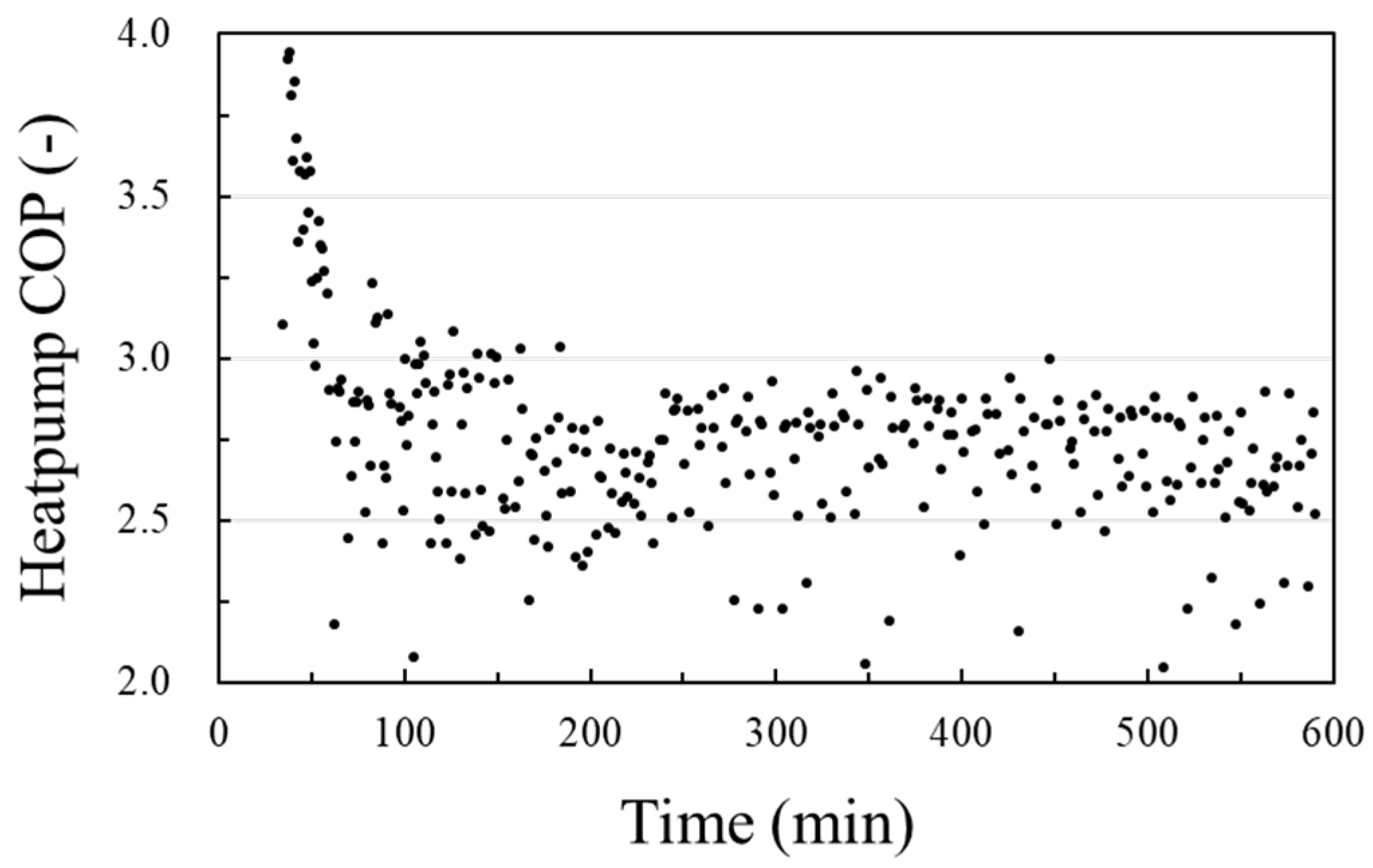
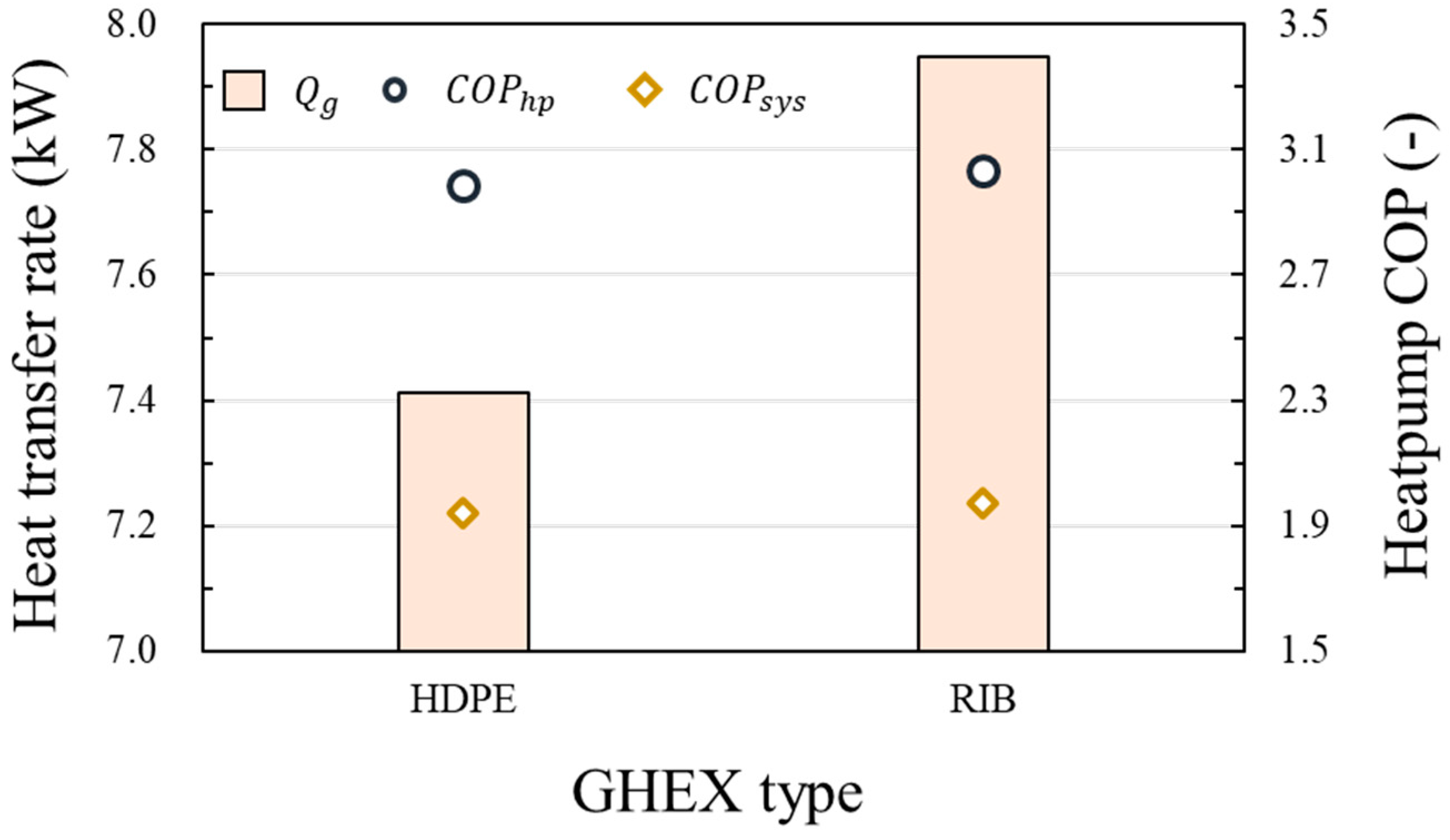


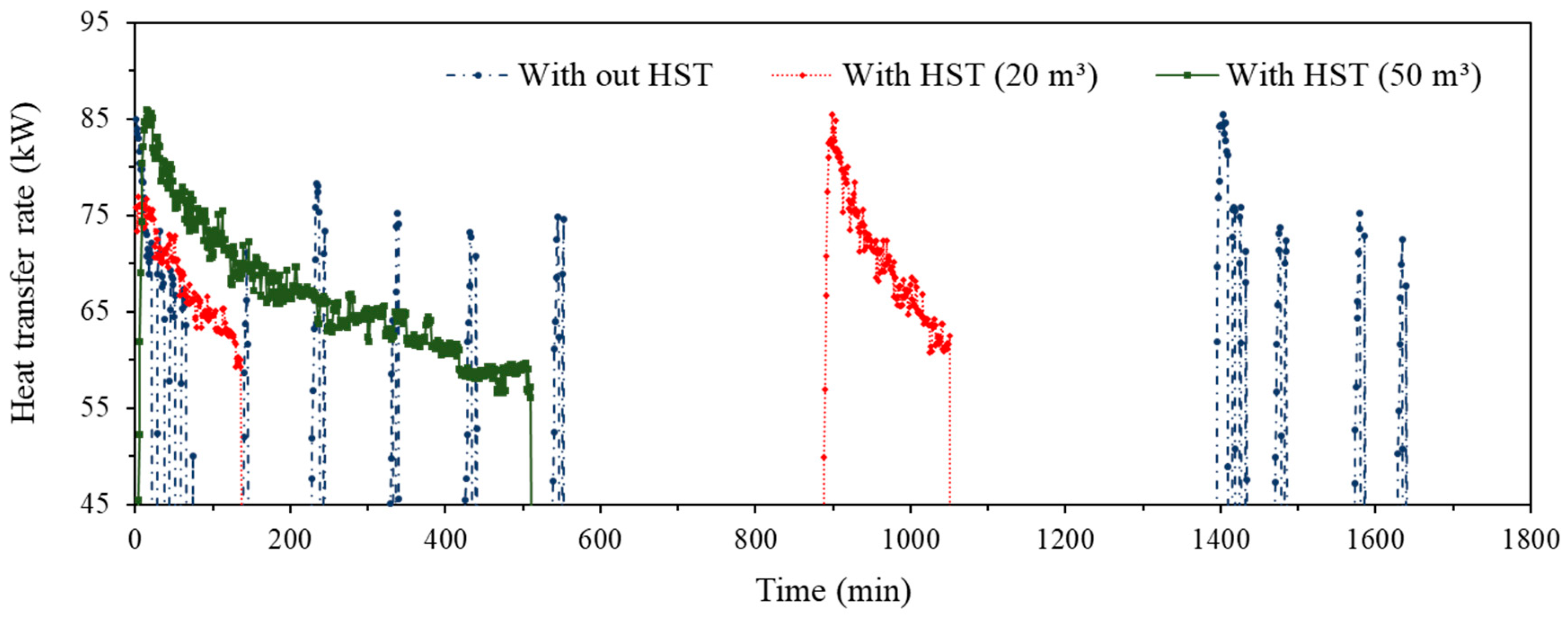
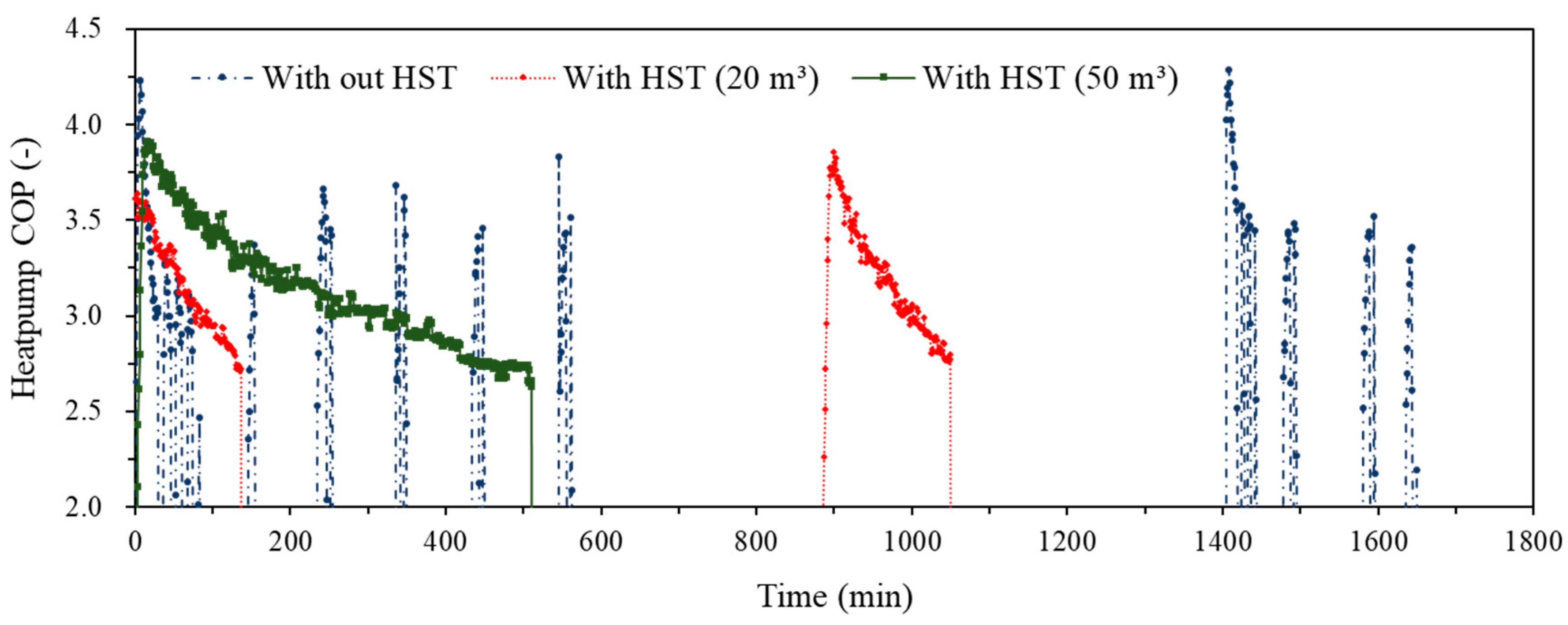
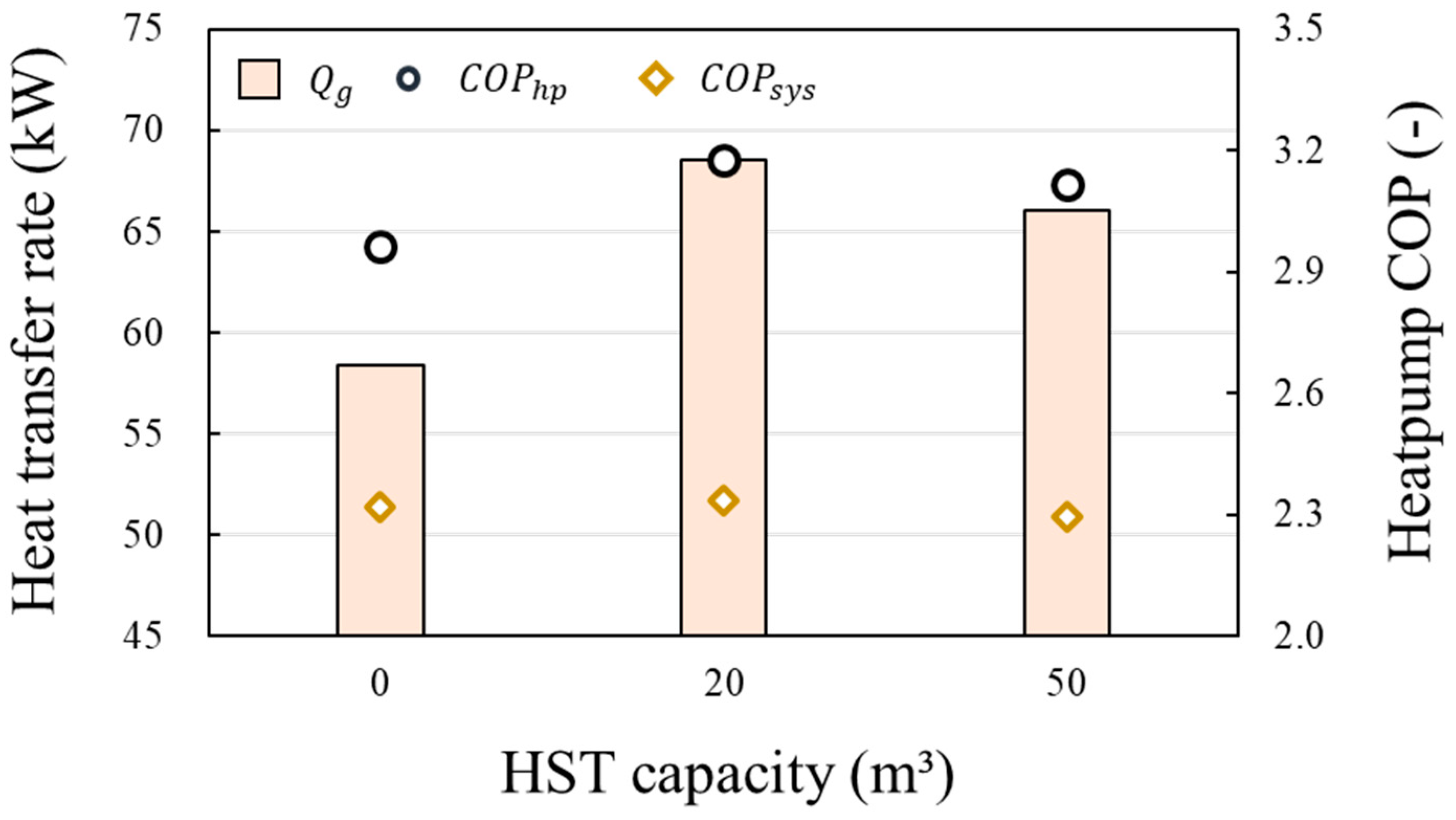


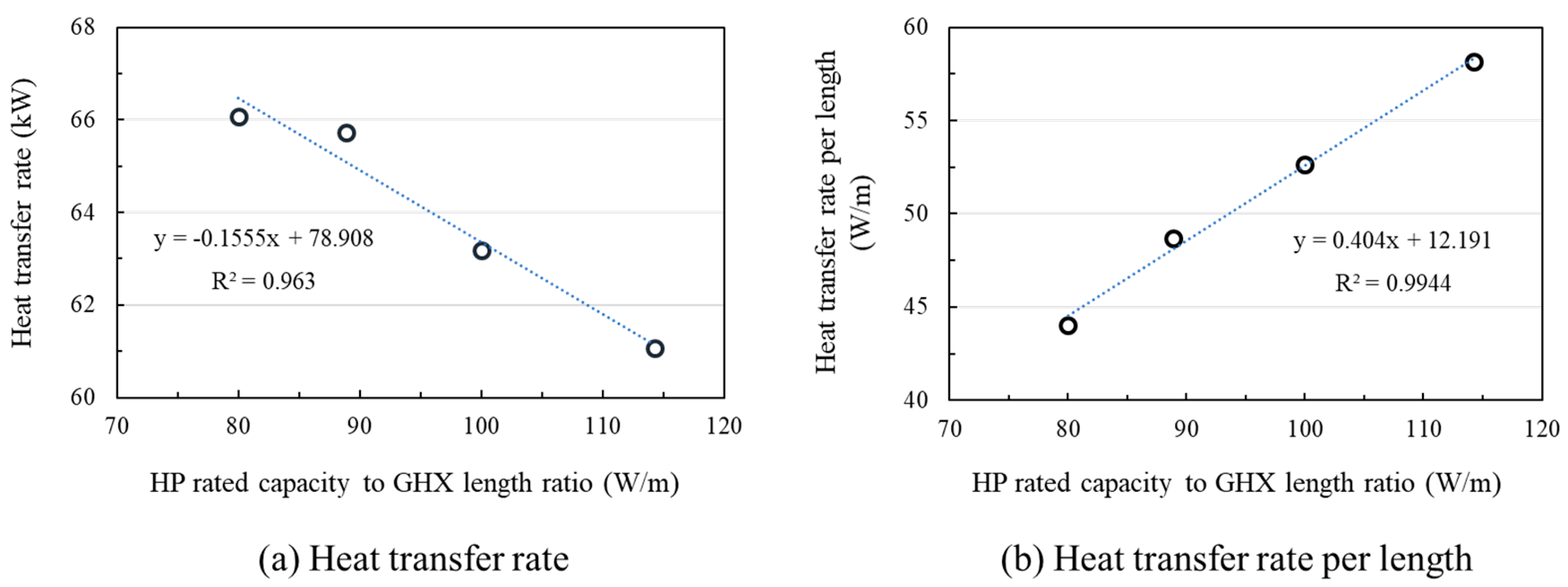
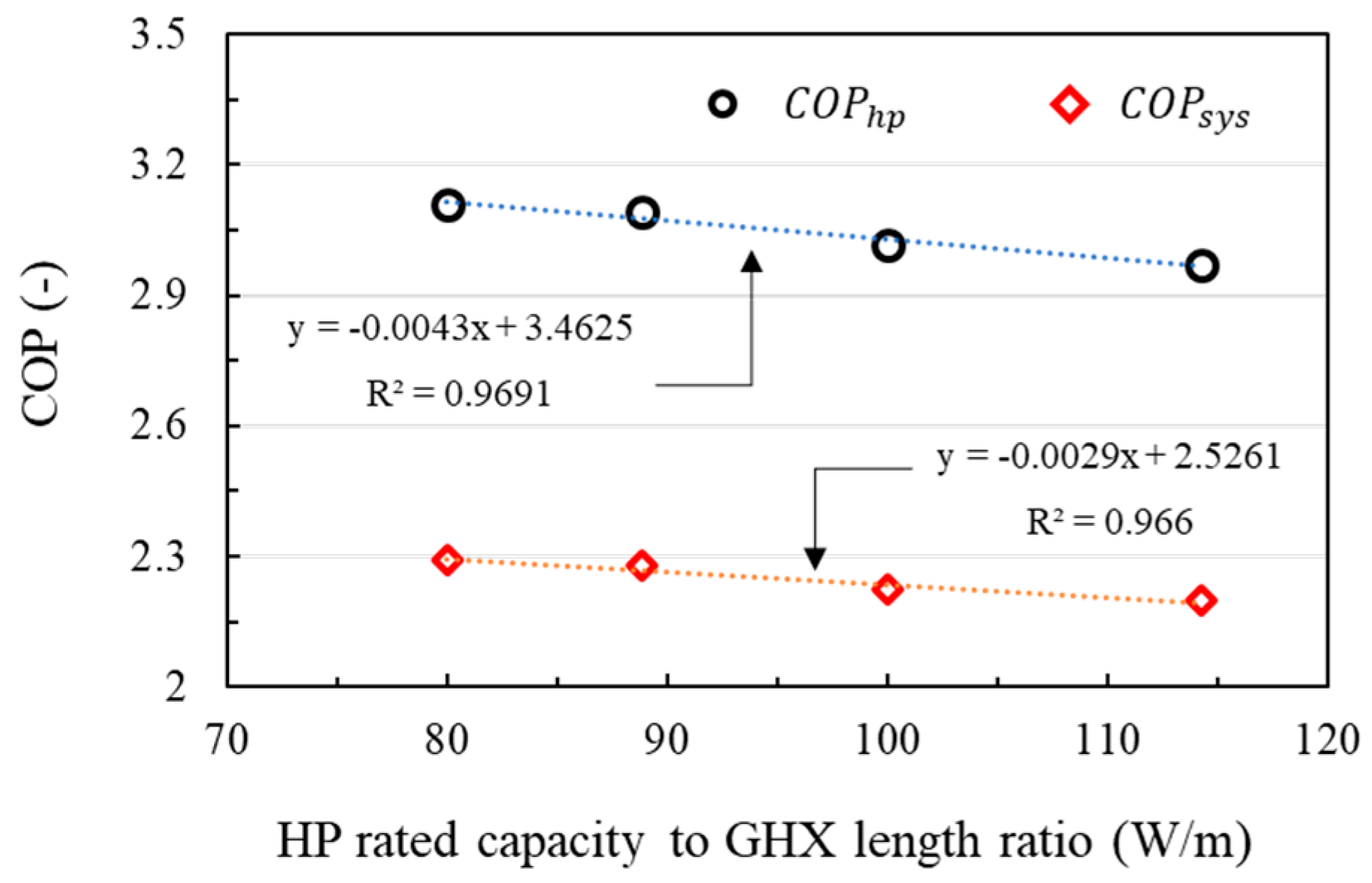
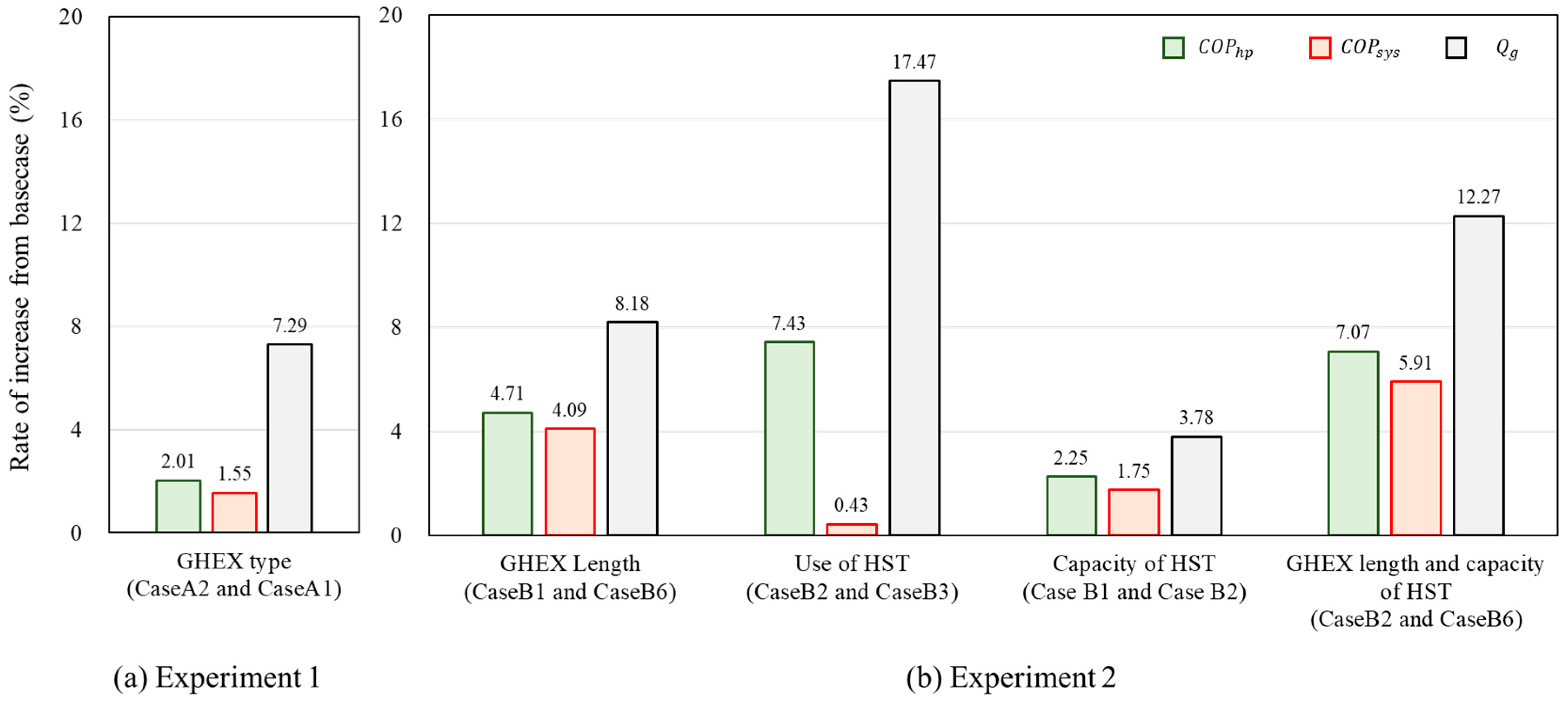
| Element | Experiment Room 1 (Site A) | Experiment Room 2 (Site B) |
|---|---|---|
| Experiment room | 85 m2 | 595 m2 |
| Operation schedule | 09:00–18:00 | 09:00–18:00 |
| Indoor set temperature | 22 °C ± 2 °C | 22 °C ± 2 °C |
| HST set temperature | 45 °C ± 5 °C | 45 °C ± 5 °C |
| Heat pump capacity | 20.11 kW (5RT) | 119.43 kW (30RT) |
| Heat storage tank capacity | 0.2 m3 | 50 m3 |
| Fan coil unit capacity | 19.8 kW × 6 | 19.8 kW × 18 |
| Ground heat exchanger length | 150 m × 2 | 150 m × (7~10) |
| Ground heat exchanger shape | HDPE/Inner rib | HDPE |
| Flow rate | 57 lpm | 340 lpm |
| Circulating pump capacity | 0.6 kW | 3.7 kW |
| Heat pump design Heating COP | 4.30 | 4.13 |
| Experiment | Equipment | GHEX Shape | GHEX Length | HST Capacity |
|---|---|---|---|---|
| Case A1 | Site A | HDPE | 300 m | 0.2 m3 |
| Case A2 | Inner rib | |||
| Case B1 | SiteB | HDPE | 1500 m | 50 m3 |
| Case B2 | 20 m3 | |||
| Case B3 | - | |||
| Case B4 | 1350 m | 50 m3 | ||
| Case B5 | 1200 m | |||
| Case B6 | 1050 m |
| Element | Measuring Equipment | Measurement Error | Uncertainty of Performance |
|---|---|---|---|
| Flow rate | Ultra Sonic Flowmeter | ±0.1% | - |
| Temperature | Thermometer (PT100) | ±0.2 °C | - |
| Power | AC Voltmeter (MT4Y-AV-34) | ±0.3% | - |
| DC Ammeter (CM1-AD04VI) | ±0.3% | - | |
| Wattmeter (DPM-TWAT-S1B1B1) | ±0.5% | - | |
| Heat excahge rate | - | - | ±4.0% |
| Heatpump COP | - | - | ±4.0% |
| System COP | - | - | ±4.0% |
| Experiment | HER | HER per m | Heat Pump COP | System COP |
|---|---|---|---|---|
| Case A1 | 7.41 kW | 24.7 W/m | 2.98 | 1.94 |
| Case A2 | 7.95 kW | 26.5 W/m | 3.04 | 1.97 |
| Case B1 | 66.1 kW | 44.1 W/m | 3.11 | 2.29 |
| Case B2 | 68.6 kW | 45.7 W/m | 3.18 | 2.33 |
| Case B3 | 58.4 kW | 38.9 W/m | 2.96 | 2.32 |
| Case B4 | 65.7 kW | 48.7 W/m | 3.09 | 2.28 |
| Case B5 | 63.2 kW | 52.7 W/m | 3.02 | 2.23 |
| Case B6 | 61.1 kW | 58.2 W/m | 2.97 | 2.20 |
© 2020 by the authors. Licensee MDPI, Basel, Switzerland. This article is an open access article distributed under the terms and conditions of the Creative Commons Attribution (CC BY) license (http://creativecommons.org/licenses/by/4.0/).
Share and Cite
Kim, H.; Nam, Y.; Bae, S.; Choi, J.S.; Kim, S.B. A Study on the Effect of Performance Factor on GSHP System through Real-Scale Experiments in Korea. Energies 2020, 13, 554. https://doi.org/10.3390/en13030554
Kim H, Nam Y, Bae S, Choi JS, Kim SB. A Study on the Effect of Performance Factor on GSHP System through Real-Scale Experiments in Korea. Energies. 2020; 13(3):554. https://doi.org/10.3390/en13030554
Chicago/Turabian StyleKim, Hongkyo, Yujin Nam, Sangmu Bae, Jae Sang Choi, and Sang Bum Kim. 2020. "A Study on the Effect of Performance Factor on GSHP System through Real-Scale Experiments in Korea" Energies 13, no. 3: 554. https://doi.org/10.3390/en13030554
APA StyleKim, H., Nam, Y., Bae, S., Choi, J. S., & Kim, S. B. (2020). A Study on the Effect of Performance Factor on GSHP System through Real-Scale Experiments in Korea. Energies, 13(3), 554. https://doi.org/10.3390/en13030554






